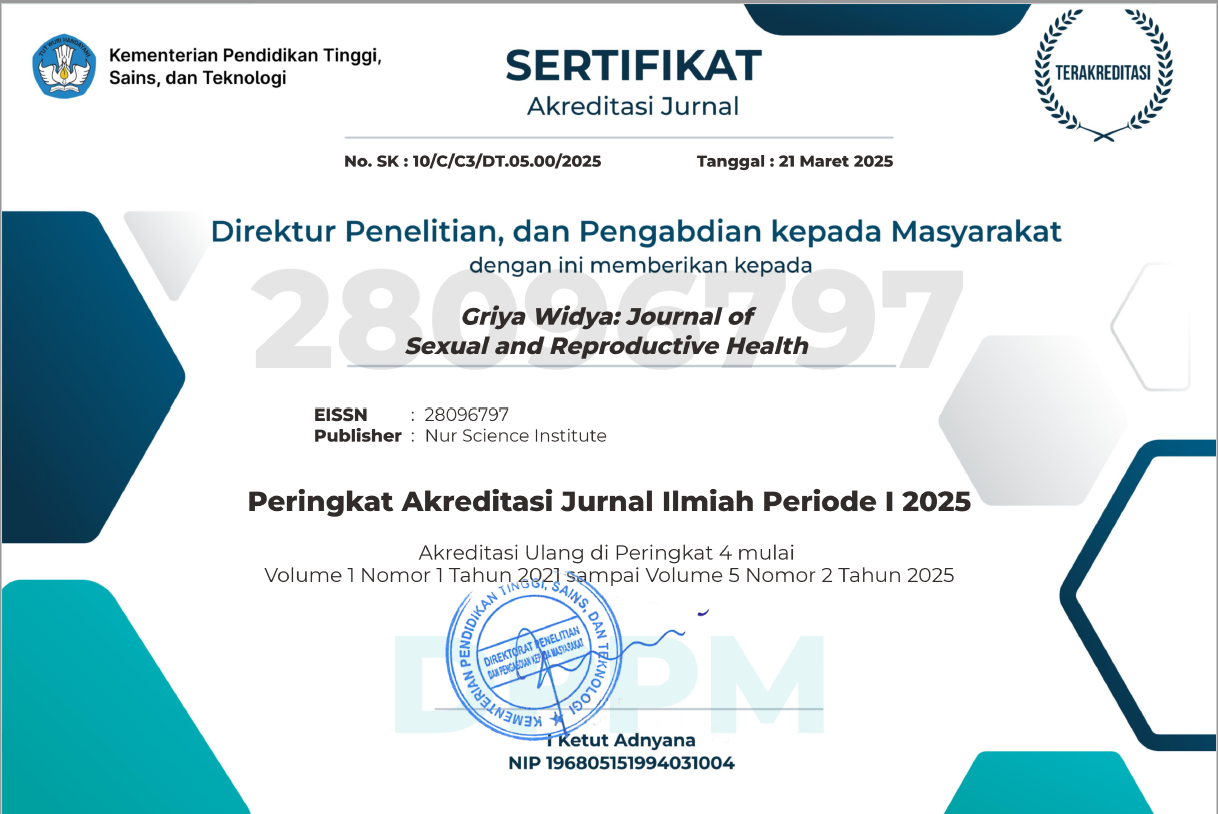Mampukah Kontrasepsi Hormonal Melindungi dari Kanker Endometrium?
Sebuah Tinjauan Pustaka
DOI:
https://doi.org/10.53088/griyawidya.v3i2.1689Keywords:
Hormonal contraception, Endometrial cancer, Progestin, Combined oral contraceptivesAbstract
Introduction: This review aims to summarize the protective mechanisms, effectiveness, and clinical implications of hormonal contraception in reducing endometrial cancer risk.
Methods: A literature review was conducted by analyzing epidemiological studies, meta-analyses, and clinical trials focusing on the relationship between hormonal contraceptives and endometrial cancer risk. The review included studies published in major medical databases such as PubMed, Scopus, and Cochrane Library.
Results: The findings indicate that COC use reduces endometrial cancer risk by 30–50%, with long-term use (≥10 years) providing up to 80% risk reduction. The protective effect persists for decades after discontinuation. Progestin-only methods, including the levonorgestrel-releasing intrauterine device (LNG-IUD) and Depo-Provera, also demonstrate substantial risk reduction by inducing endometrial atrophy and suppressing hyperplasia. The protective effects are influenced by duration of use, hormonal composition, and individual factors such as obesity and reproductive status.
Discussion: Hormonal contraception represents a viable preventive strategy, particularly for high-risk populations, including women with polycystic ovary syndrome (PCOS) and Lynch syndrome. However, risks such as thromboembolism and hormone-sensitive malignancies must be considered in clinical decision-making.
Conclusion: Hormonal contraceptives provide substantial long-term protection against endometrial cancer through multiple mechanisms. Personalized contraceptive strategies should be tailored to individual risk factors to maximize benefits while minimizing potential adverse effects.
References
Agarwal, S., Melgandi, W., Sonkar, D. R., Ansari, F. A., Arora, S., Rathi, A. K., & Singh, K. (2023). Epidemiological characteristics of endometrial cancer patients treated at a tertiary health center in National Capital Territory of India. Journal of Cancer Research and Therapeutics, 19(2), 452–456.
American Cancer Society. (2025). Birth control & cancer: Which methods raise, lower risk. https://www.cancer.org
Baker-Rand, H., & Kitson, S. J. (2024). Recent advances in endometrial cancer prevention, early diagnosis and treatment. Cancers, 16(5), 1028. https://doi.org/10.3390/cancers16051028
Clarke, M. A., Long, B. J., Sherman, M. E., et al. (2020). A prospective clinical cohort study of women at increased risk for endometrial cancer. Gynecologic Oncology, 156(1), 169–177.
Grimbizis, G. F., & Tarlatzis, B. C. (2010). The use of hormonal contraception and its protective role against endometrial and ovarian cancer. Best Practice & Research Clinical Obstetrics & Gynaecology, 24(1), 29–38.
Kamani, M., Akgor, U., & Gültekin, M. (2022). Review of the literature on combined oral contraceptives and cancer. Ecancermedicalscience, 16, 1416. https://doi.org/10.3332/ecancer.2022.1416
Karlsson, T., Johansson, T., Höglund, J., et al. (2021). Time-dependent effects of oral contraceptive use on breast, ovarian, and endometrial cancers. Cancer Research, 81(4), 1153–1162.
Mueck, A. O., Seeger, H., & Rabe, T. (2010). Hormonal contraception and risk of endometrial cancer: A systematic review. Endocrine-Related Cancer, 17(4), R263–R271.
The American College of Obstetricians and Gynecologists. (2018). Hormonal contraception and risk of breast cancer. https://www.acog.org
Thakur, L., & Thakur, S. (2023). The interplay of sex steroid hormones and microRNAs in endometrial cancer: Current understanding and future directions. Frontiers in Endocrinology, 14, 1166948. https://doi.org/10.3389/fendo.2023.1166948
Weiderpass, E., Adami, H. O., Baron, J. A., Magnusson, C., Lindgren, A., & Persson, I. (1999). Use of oral contraceptives and endometrial cancer risk (Sweden). Cancer Causes & Control, 10(4), 277–284.
Downloads
Published
How to Cite
Issue
Section
License
Copyright (c) 2024 Fitriyadi Kusuma

This work is licensed under a Creative Commons Attribution-ShareAlike 4.0 International License.
Authors who publish with this journal agree to the following terms:
The author(s) retain copyright and grant the journal the right of first publication with the work simultaneously licensed under a CC BY-SA 4.0 license that allows others to remix, adapt, and build upon the work even for commercial purposes, as long as they credit the author(s) and license their new creations under the identical terms.
License details: https://creativecommons.org/licenses/by-sa/4.0/



